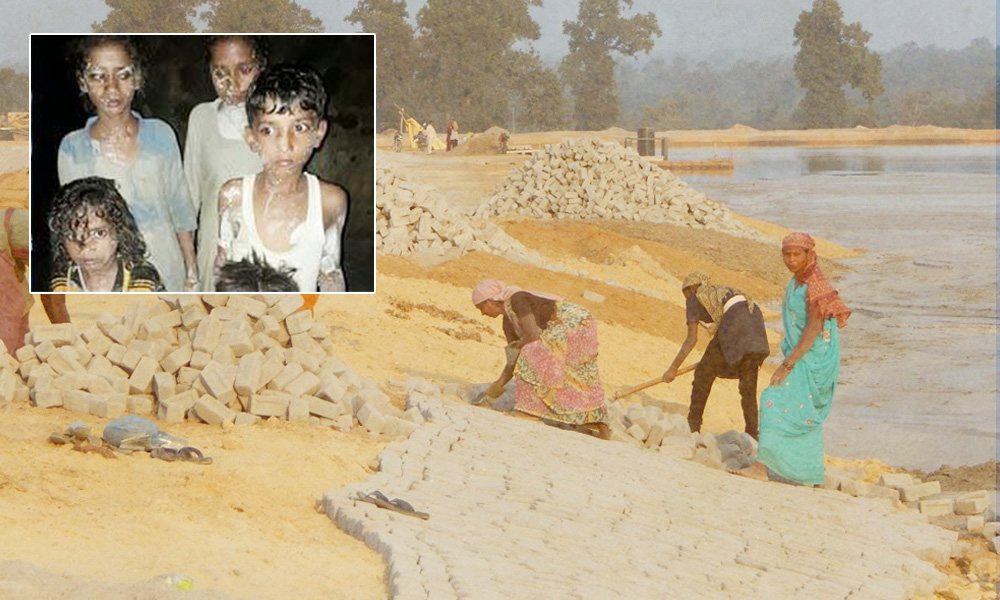
India's Dream Of Trillion Dollar Economy Is Via Coal - But What About Coal Ash Endangering Environment & Lives?
India, 28 July 2020 3:56 PM GMT | Updated 4 Aug 2022 9:47 PM GMT
Creatives : Abhishek M |
" An engineer by profession, Abhishek is the creative producer of the team, graphic designing is his passion and travelling his get away. In more ways than one, he makes the content visually appealing."
Coal Ash, the by-product of power generation using coal generally gets dumped in open grounds. Despite it being deadly pollutant, Indian regulations do not recognize coal ash as hazardous waste.
India's dream for a multi trillion dollar economy is built on large-scale infrastructure growth, manufacturing and reducing the dependence on imported goods and services. Of this, opening up commercial coal mining is touted to be the landmark reform that will affirm the move to become AtmaNirbhar Bharat (Self Reliant India). In this hurry to create windfalls for the economy, the true cost of coal - its environmental and social costs has been forgotten.
As of 2019, more than 70% of India's electricity was generated from Coal. Coal Ash, the by-product of power generation using coal generally gets dumped in open grounds without any precautionary measures, resulting in large scale contamination of the environment. In addition to this, coal ash mis-management, ash dyke breach, pipeline leaks etc continue to take place. A new report by Healthy Energy Initiative India and Community Environmental Monitoring establishes that at least 76 major coal ash pond accidents occurred across the country between 2010 and June 2020.
The report titled "Coal ash in India – A compendium of disasters, environmental and health risks" states that these accidents have caused deaths and loss of property and resulted in extensive pollution of nearby water sources, air and soil. While this data alludes to almost more than one coal ash related major incident every other month in the last decade, the report claims that this is just the tip of the iceberg as a lot of "routine" incidents of fly ash spills which occur on a regular basis go unreported.
From unlined dykes or ponds where the ash is dumped, toxins including heavy metals ash seep into the ground and contaminate groundwater. It is also seen that such ash ponds regularly give way, either due to excessive weight of the ash piled up or during monsoons as embankments breach discharging huge quantities of ash in the neighbouring areas including homes, villages, agricultural lands and water bodies. During dry seasons, these ash ponds become a source of air pollution, as dust storms carry huge clouds of ash into the environment. A disproportionate number of power plants are located close to water bodies like rivers or on the coast with ash discharge flowing directly into the environment bypassing holding ponds. Despite compelling evidence that coal ash is a serious environmental pollutant and needs to be handled in a scientific manner, Indian regulations do not recognize coal ash as hazardous waste. This allows the power companies to cut costs of maintaining engineered landfills for scientific disposal of fly ash.
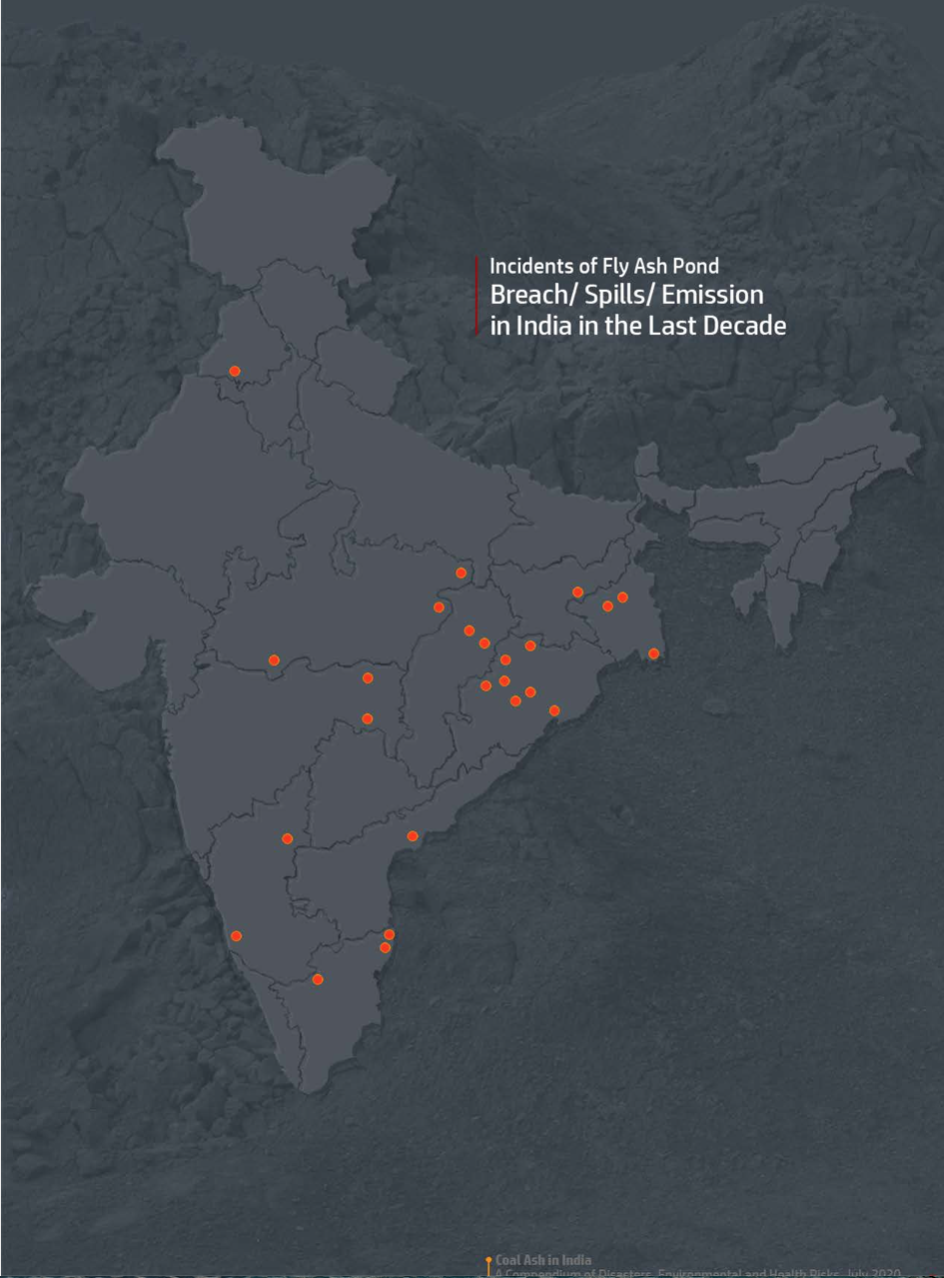
States like Madhya Pradesh, Odisha, Jharkhand, West Bengal, Tamil Nadu, Chhattisgarh and Maharashtra with highest concentrations with coal fired thermal power plants top the list of coal ash accidents.
Shweta Narayan, Coordinator of Healthy Energy Initiative India said, "While mining and coal burning have received their fair share of attention, the dangers of coal ash and the impacts of its disposal are still under the radar. The public outrage associated with coal ash pollution remains limited to big disasters. The slow poisoning of communities living around ash containment ponds goes unnoticed. This report provides an overview of the management of coal ash in India and the threat it poses to health and environment due its mismanagement".
Health Risks
According to the Ministry of Power's Central Electricity Authority (CEA), India generated 217.04 million metric tons of ash in 2018-19. This figure is expected to cross 600 million metric tons by 2032. Coal ash is known to contain toxic chemicals like arsenic, aluminum, antimony, barium, cadmium, selenium, nickel, lead and molybdenum among other carcinogens. Along with the increased risk of cancers from toxic heavy metal exposure, coal ash can affect human development, create lung and heart problems, cause stomach ailments, and contribute to premature mortality.
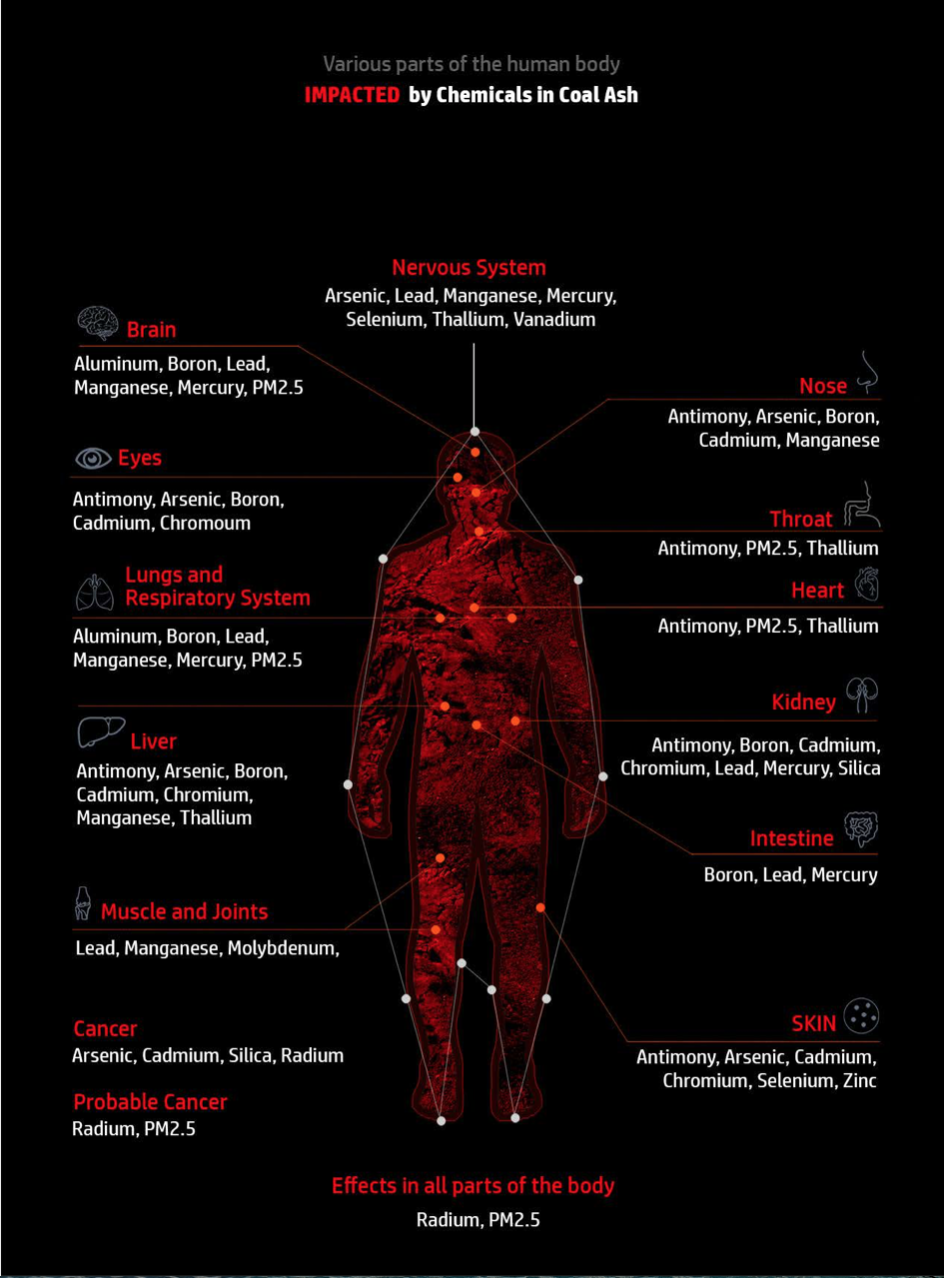
Health studies conducted among communities living close to coal mines and coal ash ponds in Chhattisgarh, India, revealed increased incidences of chronic health conditions such as hair loss and brittle hair; joint pain, body ache and backache; dry, itchy and/or discoloured skin and cracked sole, and dry cough. Higher cases of kidney and gastrointestinal complaints have also been reported.
Dr Manan Ganguli, Healthcare consultant from Cambridge, UK said, "Coal ash overall is a deadly poison that looks harmless. Typically, coal ash consists of arsenic, lead, mercury, selenium, hexavalent chromium among other carcinogens and neurotoxins. Studies have also linked fly ash with radiation exposure among workers and public. The only way to be safe is not to burn coal"
Legacy Ash
After a tryst with decades of mis-mangement of coal ash, Ministry of Environment, Forest and Climate Change (MoEF&CC) issued a Fly Ash notification on 14th September 1999 mandating the utilisation of fly ash for cement, concrete blocks, bricks, panels or any other material or for construction of roads, embankments, dams or for any other construction activity within a radius of 300 km from thermal power stations (TPPs) resulting in 100% utilisation of fly ash within a specified period.
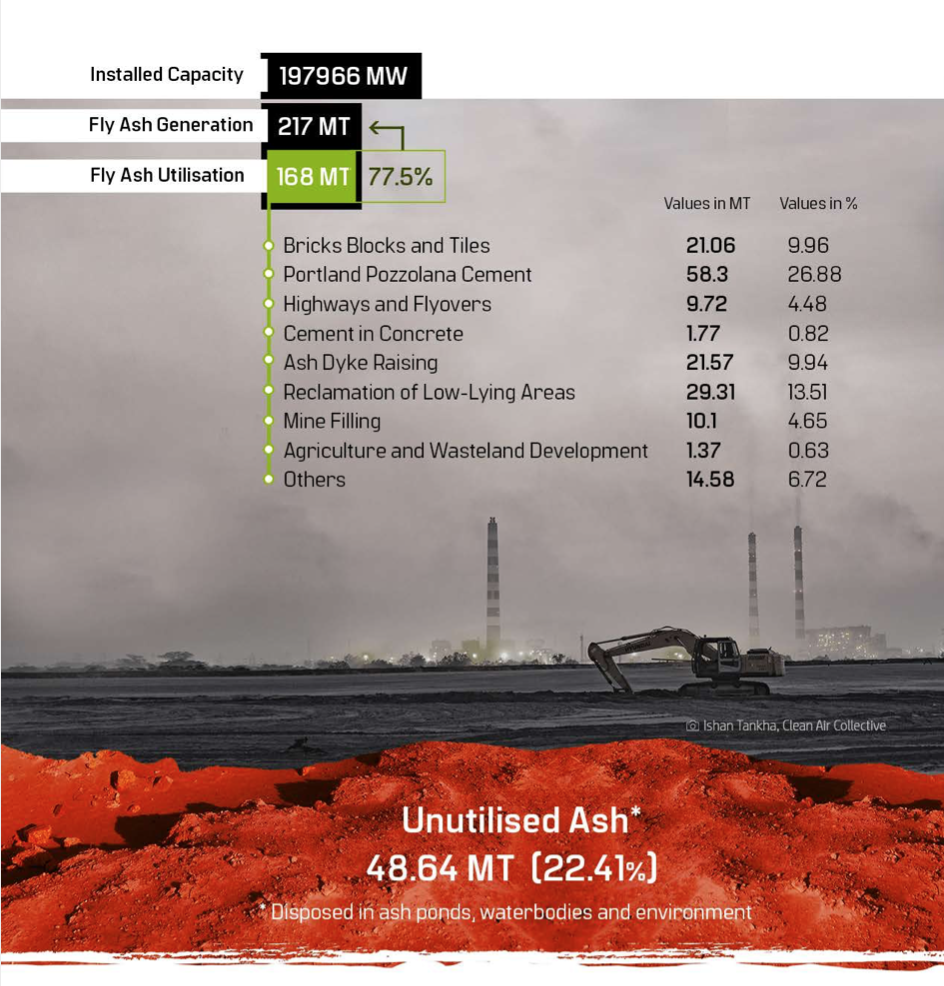
There still remains several concerns about the fate of toxins in fly ash once encapsulated into these products. It has so far been a controversial topic without a conclusive scientific consensus. Out of the total 217 million tons of coal ash generated in the year 2018-19 alone, only 168 million tons (77.5%) was utilised. Despite this, data in the report reveals that more than a billion tons of legacy ash remains unutilised in ponds and mounds all over the country.
Coal ash in India – A compendium of disasters, environmental and health risks makes the following policy recommendations:
Fixing accountability for safe management and the environmental health impacts emerging out of utilization, disposal and reuse of coal ash.
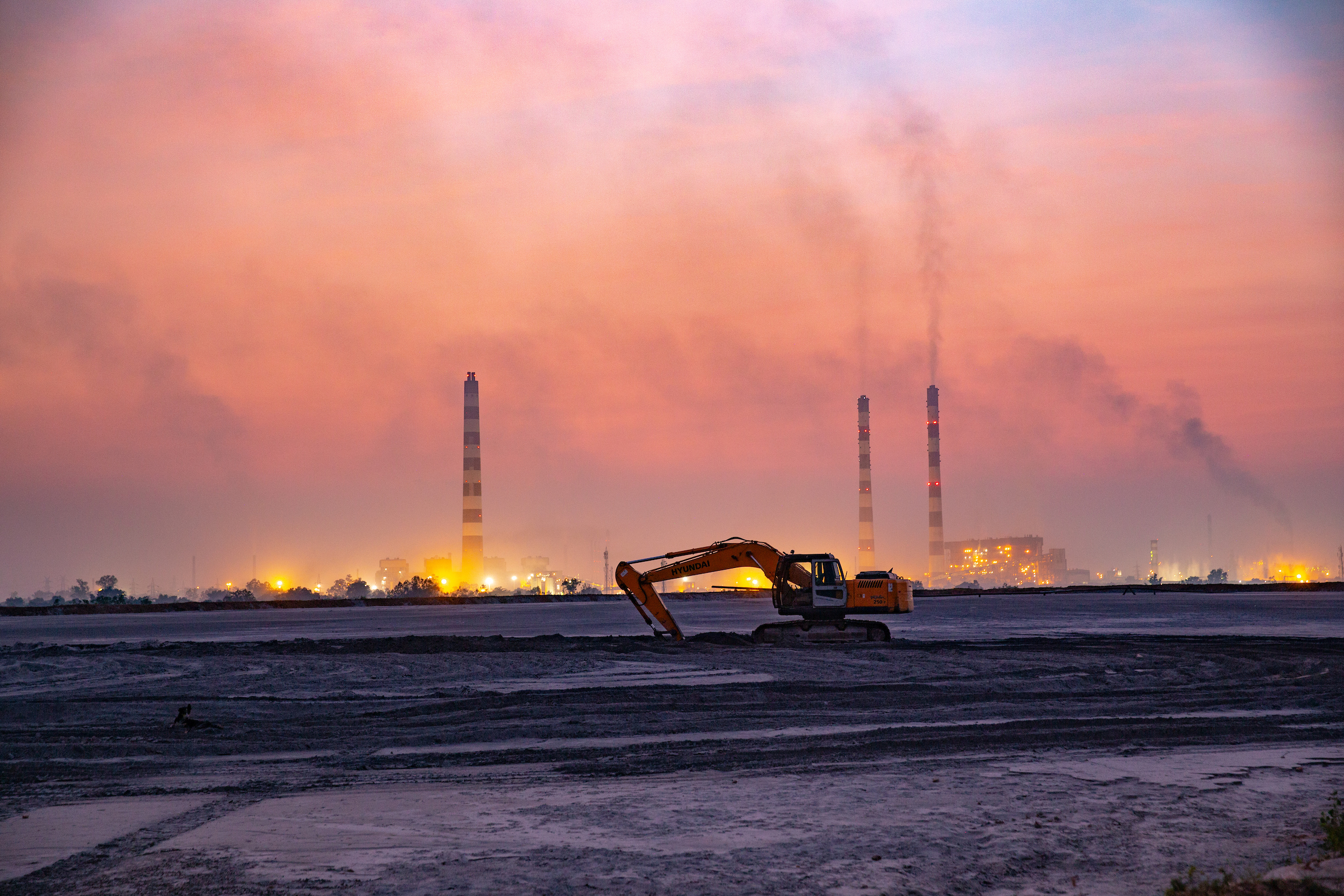
Creating a robust monitoring mechanism that includes participation of communities residing next to power plants, to ensure that all ash generated is accounted for and further defining mechanisms for remediation and paying up for health and environmental damages under polluter pays principle in case of accidents/pollution.
Need for scientific development of regulations for the containment of pond ash. This would require retrofitting existing ash ponds with impermeable HDPE liners and linking the scientific landfilling of ash with environmental clearances.
Remediation of all ash contaminated sites to be carried out as per the guidance document developed by the MoEFCC under the National Program for Rehabilitation of Polluted Sites (NPRPS) and strict fines for coal ash pollution in the environment and for health damages.
Edited by Bharat Kumar Nayak
Also Read: [Watch/Read] Do Not Let History Repeat Itself: Save Ennore Creek, Save Chennai From Floods
 All section
All section














